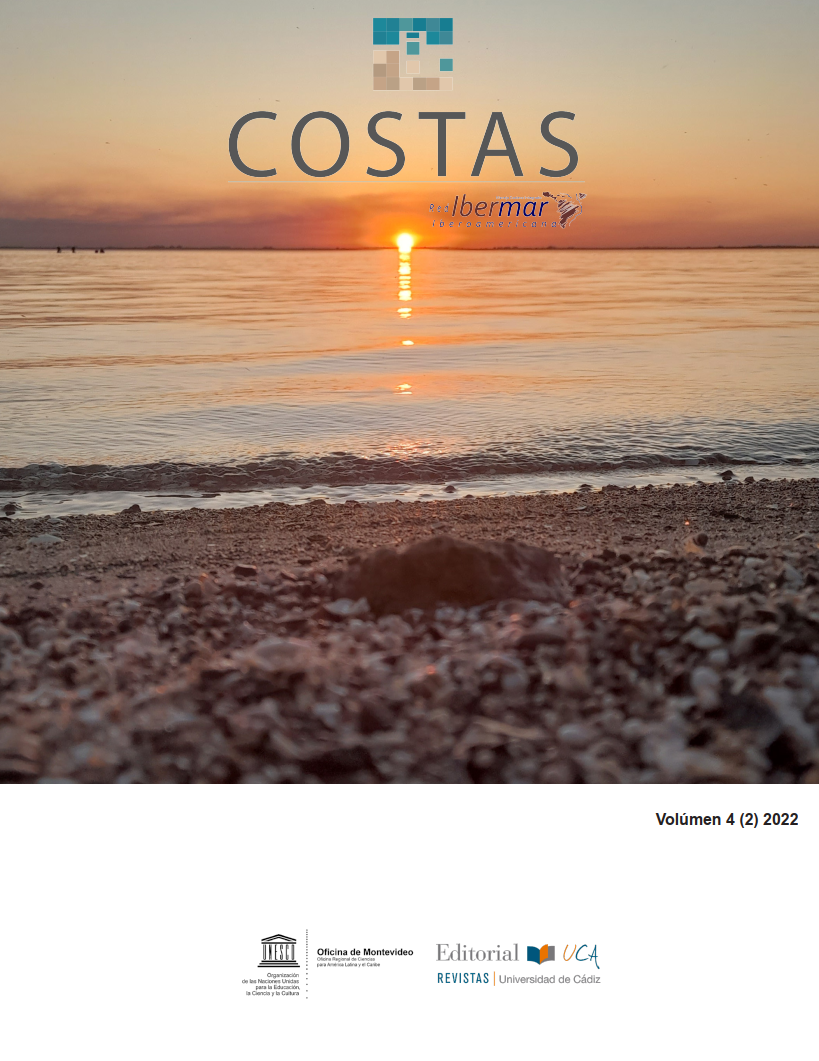Regulation of the Use of Plastic Straws in the Coastal Region of Rio Grande do Sul, Southern Brazil

DOI
https://doi.org/10.25267/Costas.2023.%20v4.i2.0704Info
Abstract
The production and consumption of plastic has increased in recent years, due to the growth in consumption patterns by the population. Disposable plastics, such as straws, have become part of everyday life. Many of these post-consumer waste end up being disposed of incorrectly and, due to their high durability, they remain in the environment for hundreds of years, which can cause impacts to aquatic fauna. Plastic straws are among the most common waste found in beach cleaning actions around the world. In view of this problem, in several locations of the world, regulations have arisen regarding the prohibition or restriction of the use of this material. In order to evaluate the positioning of the municipalities of the coastal zone of Rio Grande do Sul, in southern Brazil, about this topic, a survey of existing municipal legislation was carried out regarding the prohibition of the use of plastic straws. The state of Rio Grande do Sul has 16 municipalities bordering the sea, including a resident population of about 590,000 inhabitants. Of these municipalities, eight directly prohibit the use of plastic straws. No regulation provides for exception for the use of plastic straws, but all point to the use of biodegradable materials in replacement of plastic and 75% indicate replacement by paper. However, there is a lack of specification or technical criteria for classification and identification of the types of allowed straws. Only 25% of the laws mentioned or proposed environmental education measures and none include economic incentives for the use of alternative materials. However, all point to administrative and economic sanctions in case of non-compliance with the terms of the law. Regulation is believed to be the initial step towards eliminating plastic straws. Nevertheless, implementations of incentive measures are necessary for the development of alternative solutions for consumption, since the simple prohibition of this product can lead to increased use of other disposable items or the use of other materials that are difficult to degrade. In addition, it is essential that the measures adopted are broader and aimed at reducing the consumption of single-use materials as a whole.
Keywords
How to Cite
License
Copyright (c) 2023 Daiana Maffessoni, Julia Goncalves Simões do Carmo, Marina Vargas Brandão, Paulo Henrique Ott.

This work is licensed under a Creative Commons Attribution-NonCommercial-NoDerivatives 4.0 International License.
References
Atlas do Plástico: Fatos e números sobre o mundo dos polímeros sintéticos / organização Marcelo Montenegro, Manoela Vianna , Daisy Bispo Teles. -- 1. ed. -- Rio de Janeiro: Fundação Heirich Böll, 2020.
Ardoin, N.M., Bowers, A.W., Gaillard, E., 2020. Environmental education outcomes for
conservation: a systematic review. Biol. Conserv. 241, 108224 https://doi.org/10.1016/j.biocon.2019.108224
ASSEMBLEIA LEGISLATIVA DO ESTADO DE GOIÁS. LEI Nº 20.597, DE 04 DE OUTUBRO DE 2019. Dispõe sobre a obrigatoriedade de utilização de canudo de material biodegradável em restaurantes, bares, lanchonetes e estabelecimentos similares no âmbito do Estado de Goiás. Disponível em: <https://leisestaduais.com.br/go/lei-ordinaria-n-20597-2019-goias-dispoe-sobre-a-obrigatoriedade-de-utilizacao-de-canudo-de-material-biodegradavel-em-restaurantes-bares-lanchonetes-e-estabelecimentos-similares-no-a>. Acesso: mar. 2022
BAHAMAS. 2019. ENVIRONMENTAL PROTECTION (CONTROL OF PLASTIC POLLUTION) BILL, 2019. Disponível em: <https://www.bahamas.gov.bs/wps/wcm/connect/7cb2452c-fa3a-4e8f-a10b-96fa0b1b1ad3/EnvironmentalProtection+%28Control+of+Plastic+Pollution%29+Bill%2C2019_01.pdf?MOD=AJPERES#:~:text=The%20Environmental%20Protection%20(Control%20of%20Plastic%20Pollution)%20Bill%2C%202019,compostable%20single%20use%20plastic%20bags.>. Acesso: mar. 2022
Castelliano, C., Grajzl, P., Watanabe, E., 2021. How has the Covid19 pandemic impacted
the courts of law? Evidence from Brazil. Int. Rev. Law Econ., 105989 https://doi.org/10.1016/j.irle.2021.105989
Ciezka, B., Rybinska, A., 2020. Fundacja Rozwoju Systemu Edukacji, Polskie Towarzystwo Ewaluacyjne. In: Evaluation in Educational Practice, Evaluation in Educational Practice. Wydawnictwo FRSE. https://doi.org/10.47050/66515246.
Chitaka, T. Y., Russo, V., Blottnitz, H. V. 2020. In pursuit of environmentally friendly straws: a comparative life cycle assessment of five straw material options in South Africa. The International Journal of Life Cycle Assessment (2020) 25:1818–1832. https://doi.org/10.1007/s11367-020-01786-w
COREDE Litoral. Perfil Socioeconômico do Corede Litoral. Governo do Estado do Rio Grande do Sul, Secretaria do Planejamento, Mobilidade e Desenvolvimento Regional, 2015.
Danopoulos, E., et al. 2020. Microplastic Contamination of Seafood Intended for Human Consumption: A Systematic Review and Meta-Analysis. Environmental Health Perspectives. Vol. 128, No. 12. https://doi.org/10.1289/EHP7171
Geyer, R., Jambeck, J.R., Law, K.L., 2017. Production, use, and fate of all plastics ever made. Sci. Adv. 3.
Herberz, T.; Barlow, C. Y.; Finkbeiner, M. 2020. Sustainability Assessment of a Single-Use Plastics Ban. Sustainability 2020, 12, 3746; doi:10.3390/su12093746
Instituto Brasileiro de Geografia e Estatística. Municípios defrontantes com o mar 2020. Disponível em:
<https://www.ibge.gov.br/geociencias/organizacao-do-territorio/estrutura-territorial/24072-municipios-defrontantes-com-o-mar.html?=&t=downloads. Acesso: mar 2022.
Instituto Brasileiro de Geografia e Estatística. Estimativas da população residente com data de referência 1o de julho de 2021. Diretoria de Pesquisas, Coordenação de População e Indicadores Sociais, Disponível em: < https://cidades.ibge.gov.br/>. Acesso: abr 2022.
INSTITUTO IDEAIS. Normas e tipos de plásticos biodegradáveis. 2019. Disponível em:
<http://i-ideais.org.br/norma-e-tipos-de-plasticos-biodegradaveis/>. Acesso: mar 2022.
Li, P. et al. 2020. Characteristics of Plastic Pollution in the Environment: A Review. Bulletin of Environmental Contamination and Toxicology. https://doi.org/10.1007/s00128-020-02820-1
OCEAN CONSERVANCY. 2021. We clean on. Report 2021. Disponível em: <https://oceanconservancy.org/wp-content/uploads/2021/09/2020-ICC-Report_Web_FINAL-0909.pdf>. Acesso: 09 novembro 2021.
PLASTICS EUROPE. Plastics - the facts 2021. Disponível em: https://plasticseurope.org/knowledge-hub/plastics-the-facts-2021/. Acesso: mar. 2022.
Salazar-Perez, C. et al. 2021. First insight into plastics ingestion by fish in the Gulf of California, Mexico. Marine Pollution Bulletin 171 112705. https://doi.org/10.1016/j.marpolbul.2021.112705
UN - environment programme. POLICIES, REGULATIONS AND STRATEGIES IN LATIN AMERICA AND THE CARIBBEAN TO PREVENT MARINE LITTER AND PLASTIC WASTE. January 2021. Disponível em: <https://wedocs.unep.org/bitstream/handle/20.500.11822/34931/Marine_EN.pdf?sequence=1&isAllowed=y>. Acesso: mar 2022
Wagner, T.P., Toews, P., 2018. Assessing the use of default choice modification to reduce consumption of plastic straws. Detritus - Volume 04 - December 2018 Pages 113-121. DOI: 10.31025/2611-4135/2018.13734.
Zanghelini, G. M. et al. 2020. Comparative life cycle assessment of drinking straws in Brazil. Journal of Cleaner Production 276 123070. https://doi.org/10.1016/j.jclepro.2020.123070






